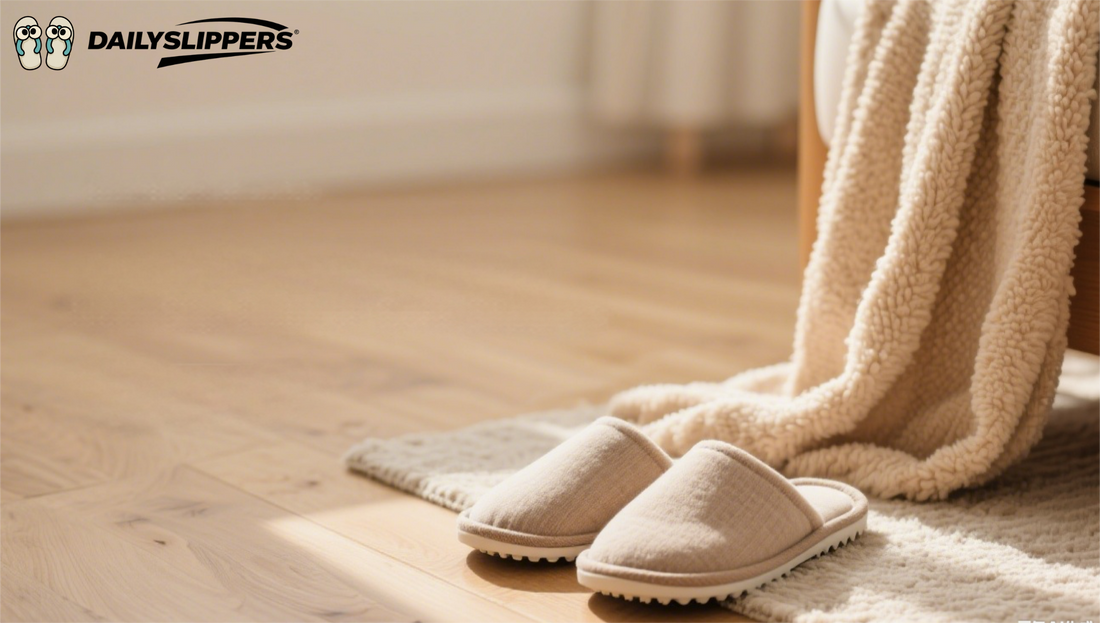
Non-Slip Rubber Sole Slippers: The Complete 2025 Buyer’s Guide
Share
If you need house shoes that won’t slide on tile, wood, or bathroom floors, non-slip rubber sole slippers are your best friend. This guide explains why rubber outsoles matter, how they compare with other materials, what features to look for, and who benefits most—from kids to seniors. Use it to pick a pair that’s comfortable, durable, and safe.
Why choose non-slip rubber soles?
Grip you can trust. Rubber has a naturally high coefficient of friction, so it grips better on smooth or wet surfaces than foam-only outsoles.
Durability. Quality rubber resists abrasion and cracking, giving your slippers a longer life for daily wear.
Noise + comfort balance. Compared with hard plastics, rubber flexes quietly and absorbs impact—great for kitchens, hallways, and nighttime use.

Rubber vs. other outsole materials
- Rubber vs. EVA: EVA is feather-light and cushy, but it can be slick when wet. A rubber outsole (or rubber inserts) adds reliable traction without losing comfort.
- Rubber vs. TPR: TPR grips well and is economical, but rubber usually wins on long-term durability and cold-weather flexibility.
- Rubber + foam hybrid: Many premium slippers use foam midsole for comfort + rubber bottom for traction—the best of both worlds.
Who needs non-slip rubber sole slippers most?
- Busy kitchens & bathrooms – water drips happen; traction prevents slips.
- Parents & kids – running around the house is safer with grippy soles.
- Seniors & recovery – extra stability for balance and confidence.
- Pet owners – hair and dust on the floor reduce friction; rubber brings it back.
- Indoor/outdoor wearers – quick trips to the mailbox, garden, or garage.
Features to look for (checklist)
- Patterned tread: Look for herringbone, wavy, or diamond patterns that channel water away and add bite.
- Full-length rubber coverage: Avoid tiny dots; a larger contact area = more consistent grip.
- Heel stability: Slight heel cup or arch sidewalls prevent side-to-side wobble.
- Midsole cushioning: Memory foam or EVA for step-in softness; rubber alone can feel firm.
- Upper materials: Choose plush/fleece for winter, breathable mesh or open toe for summer.
- Fit with socks: If you wear thick socks, size up for a relaxed, safe fit.
- Weight: Rubber adds grams; balance traction with comfort for your daily routine.
Best types of non-slip rubber sole slippers
1) Cozy house booties (winter warmth)
Fleece-lined uppers with rubber outsoles keep feet warm and steady on cold tile.
Great for: evening routines, movie nights, chilly floors.
Shop: /collections/warm-slippers
2) Clog & slide hybrids (indoor/outdoor)
EVA body for comfort, rubber bottom for outdoor steps. Easy to hose off.
Great for: kitchen runs, mailboxes, patios.
Shop: /collections/indoor-outdoor-slippers
3) Bathroom & spa slippers (quick-dry + grip)
Water-friendly uppers plus grooved rubber soles reduce slipping risk when wet.
Great for: bathrooms, gyms, dorms.
Shop: /collections/bathroom-slippers
4) Kids’ non-slip rubber sole slippers
Rounded edges, flexible uppers, and treaded rubber bottoms for safer play.
Shop: /collections/kids-slippers
Sizing & fit tips
- Between sizes? Go one size up—especially if you add socks or insoles.
- Wide feet: Choose open-toe or adjustable straps to avoid side pressure.
- Break-in: Rubber flexes more after a day or two; cushion molds to your foot.
Care & longevity
- Spot clean uppers with mild soap; avoid high heat that can harden rubber.
- Rinse tread grooves to remove dust, hair, or soap film that reduces traction.
- Air-dry only. Keep away from radiators and direct sunlight to prevent warping.
- Rotate pairs (winter/wet vs. light/summer) to extend life.
Common mistakes to avoid
- Foam-only soles in wet areas. Comfortable but not ideal for grip.
- Smooth bottoms. If the tread looks like a flat sheet, skip it.
- Too loose. Heel lift can defeat traction; secure fit = safer steps.
FAQ: Non-Slip Rubber Sole Slippers
Are rubber-soled slippers noisy on hardwood?
Quality rubber is quieter than hard plastics and grips better, so you’ll hear less squeak and feel more control.
Can I wear them outdoors?
Yes—choose pairs labeled indoor/outdoor with thicker rubber tread.
Do rubber soles mark floors?
Non-marking rubber is standard on modern slippers; if you’re concerned, test on a hidden corner.
How often should I replace them?
When tread flattens, grip drops. Heavy daily use: 6–12 months; light use: longer.
Ready to step safer?
Explore our curated collection of non-slip rubber sole slippers for men, women, and kids:
DAILYSLIPPERS
- “Most slippers use EVA for lightweight cushioning, but adding a rubber outsole improves grip and durability.”
- “For holiday comfort, many families even buy themed slippers as part of their Christmas traditions.”
